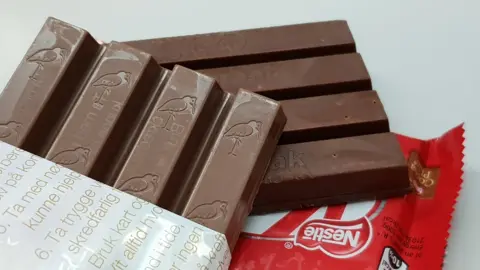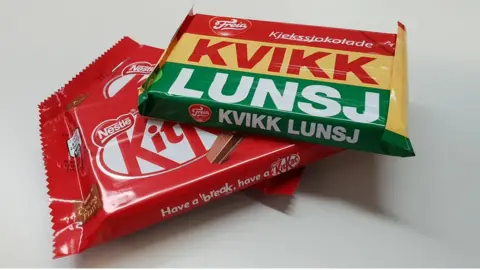Kit Kat case: No break for Nestlé in trademark row
 BBC
BBCEven if it looks like a Kit Kat, it might not be.
The European Court of Justice has thrown out an appeal by the chocolate bar's maker, Nestlé, which argued that it owns the shape of the teatime treat.
Nestlé has spent more than a decade fighting to trademark the four-fingered wafer shape - something that rival Cadbury had fought hard against.
But Wednesday's judgement found that a previous court had been right to annul the decision by Europe's trademark group.
That could bring an end to the snack's protected European status - and a saga that has proved expensive for both sides.
It also takes the pressure off identical treats like Norway's Kvikk Lunsj - pronounced "quick lunch" and which has been around for 80 years - and opens the door to own-brand imitations at your local supermarket.
A tale of four fingers
British and US readers may not even have heard of Kvikk Lunsj.
Norwegians, though, have national pride in the snack, and its long-running image as a meal on the go for healthy Scandinavian hikers.
Its chocolate has a different flavour from the Kit Kat, similar to parent company Mondelez's Milka brand. Taste-testing from the Guardian newspaper last year concluded that Kvikk Lunsj was, in fact, the superior product.
The Norwegian bar has been made since 1937, a mere two years after Kit Kat - originally called Rowntree's chocolate crisp - hit the market in 1935.
For 65 years, the two crispy treats lived together in harmony - until Nestlé went on the offensive.
In 2002, the global chocolate giant applied for a trademark in Europe for Kit Kat. There was no issue with the bar itself, embossed with the Kit Kat logo.
But it also applied for the trademark for the shape of a Kit Kat - or "four trapezoidal bars aligned on a rectangular base" as a top EU legal adviser put it.
 EUOIP
EUOIPAfter four years of back-and-forth, the EU trademark granted Nestlé the shape as a trademark.
The makers of Kvikk Lunsj, Mondelez, also owns brands including Cadbury, Milka, Oreo, and Toblerone - and Cadbury took issue with Nestlé's new trademark.
Mondelez also makes the Leo bar - another four-fingered chocolate treat.
In 2007, the court battle began in earnest, see-sawing from one side to the other during appeal after appeal.
What's in a shape?
Wednesday's ruling threw out Nestlé's appeal, telling the EU trademark office it has to "reconsider" its decision - essentially annulling Kit Kat's claim.
The case was about whether the brand had become distinctive enough to deserve its trademark - that its shape alone was how people recognise the snack.
In 2016, a lower EU court decided that Nestlé had to prove a Kit Kat was recognisable in every EU country - and no evidence had been provided for Belgium, Ireland, Greece and Portugal.
And none of the parties involved - Mondelez, Nestlé, or the European trademark office - were happy about that.

Nestlé and the EU's trademark office appealed against the 2016 decision. If proof of distinctiveness had to be shown for every single member state, they argued, no company could ever reach that high standard.
Mondelez, meanwhile, argued that it was wrong to conclude that Kit Kat had "distinctive character" anywhere - including countries like the UK, Germany and France.
The European court threw out all those objections.
The result is that the EU's top court has now declared that it's not enough to prove that a product has become iconic in "a significant part" of the EU - it has to be proven across all the markets of the bloc, not just some.
Is this the end of the road?
Nestlé said that Wednesday's judgement was "not the end of the case" and that it believed the EU trademark office will side with the company anyway.
"We think the evidence proves that the familiar shape of our iconic four-finger Kit Kat is distinctive enough to be registered as an EU trademark," a spokesman said.
John Coldham, partner at the UK law firm Gowling WLG, said that rather than cancelling the trademark the court decided it should never have been awarded at all on the basis of the evidence.
That means the decision heads back to the EU trademark office.
"Assuming the EU Intellectual Property Office does not have evidence that the shape is distinctive across the EU, I would expect it to remove the mark from the register now," Mr Coldham said.
"It is open to Nestlé to apply again, and to put stronger evidence in, so this may well not be the end of the road," he added.
"No-one is saying it is impossible to get a trade mark for the Kit Kat shape - just that there needs to be evidence that the shape is distinctive of Kit Kat in every part of the EU."
So the Kit Kat is set to lose its EU trademark - for now. But there is still a fight to be fought.
Triangular trials
European status aside, chocolate is serious business for trademark lawyers on a country-by-country basis.
Nestlé had been looking for Europe-wide protection for the Kit Kat shape. But the trademark still exists on national level in some countries, including France, Germany, Spain and Italy.
When the UK considered it, however, a lengthy court case ended in a 16,000-word ruling that Kit Kat had "no inherent distinctiveness".
Cadbury, meanwhile, lost its own trademark battle when it tried to register a shade of purple.
And, back in 2006, a case involving gold chocolate bunnies asked similar questions to the Kit Kat saga.
 Getty Images
Getty ImagesSwiss chocolatier Lindt applied for a trademark for its Easter bunnies with a red ribbon, which are iconic in many countries - but not all.
In Germany, the Riegelein company also made gold-wrapped bunnies, and the case made it to both European and German courts - where Lindt eventually lost.
And while Mondelez won the argument that you can't trademark the shape of a Kit Kat, it's sure you can trademark a Toblerone - which it owns.
Toblerone's shape was registered in 1998 - but was only put to the test last year, when British retailer Poundland designed an off-brand version.
Featuring two rows of triangular bumps rather than one, Poundland argued that its copycat wasn't a trademark infringement - especially since Toblerone had changed the shape of their UK product to reduce weight.
That disagreement was settled out of court.
